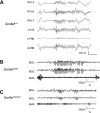Heterozygous mutations of the voltage-gated sodium channel SCN8A are associated with spike-wave discharges and absence epilepsy in mice
- PMID: 19254928
- PMCID: PMC2667290
- DOI: 10.1093/hmg/ddp081
Heterozygous mutations of the voltage-gated sodium channel SCN8A are associated with spike-wave discharges and absence epilepsy in mice
Abstract
In a chemical mutagenesis screen, we identified the novel Scn8a(8J) allele of the gene encoding the neuronal voltage-gated sodium channel Na(v)1.6. The missense mutation V929F in this allele alters an evolutionarily conserved residue in the pore loop of domain 2 of Na(v)1.6. Electroencephalography (EEG) revealed well-defined spike-wave discharges (SWD), the hallmark of absence epilepsy, in Scn8a(8J) heterozygotes and in heterozygotes for two classical Scn8a alleles, Scn8a(med) (null) and Scn8a(med-jo) (missense). Mouse strain background had a significant effect on SWD, with mutants on the C3HeB/FeJ strain showing a higher incidence than on C57BL/6J. The abnormal EEG patterns in heterozygous mutant mice and the influence of genetic background on SWD make SCN8A an attractive candidate gene for common human absence epilepsy, a genetically complex disorder.
Figures





References
-
- Kearney J.A., Meisler M.H. Encyclopedia of Basic Epilepsy Research. Elsevier; (in press)
-
- Meisler M.H., Plummer N.W., Burgess D.L., Buchner D.A., Sprunger L.K. Allelic mutations of the sodium channel SCN8A reveal multiple cellular and physiological functions. Genetica. 2004;122:37–45. - PubMed
-
- Raman I.M., Sprunger L.K., Meisler M.H., Bean B.P. Altered subthreshold sodium currents and disrupted firing patterns in Purkinje neurons of Scn8a mutant mice. Neuron. 1997;19:881–891. - PubMed
Publication types
MeSH terms
Substances
Grants and funding
LinkOut - more resources
Full Text Sources
Other Literature Sources
Molecular Biology Databases

